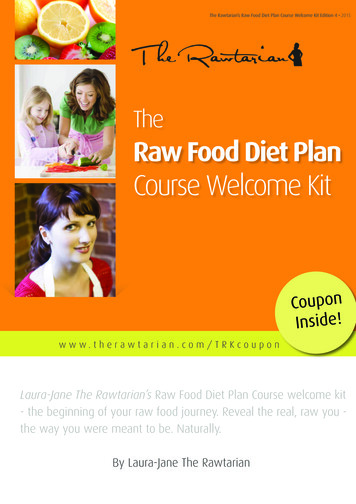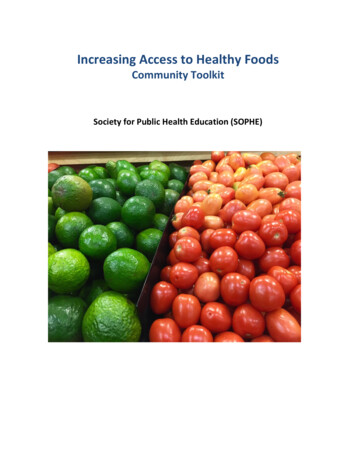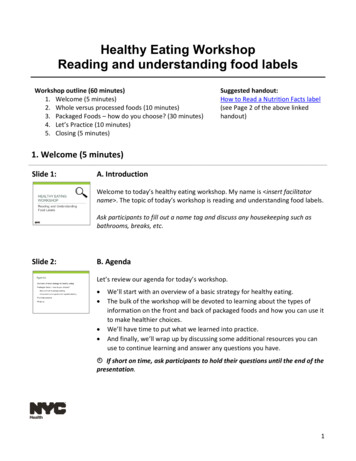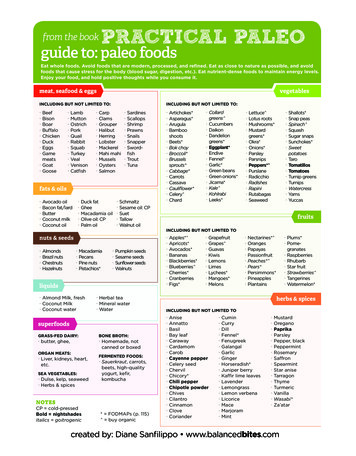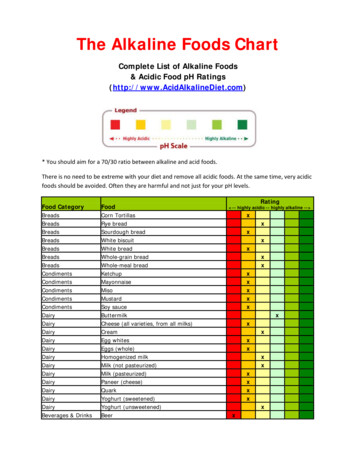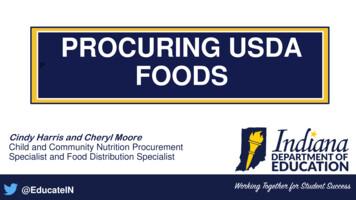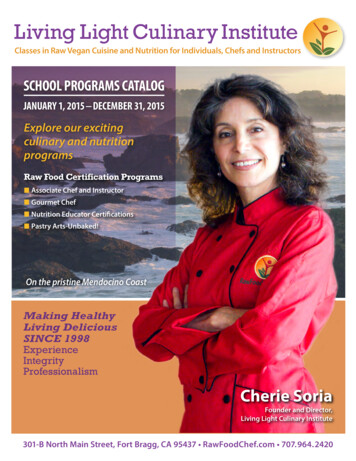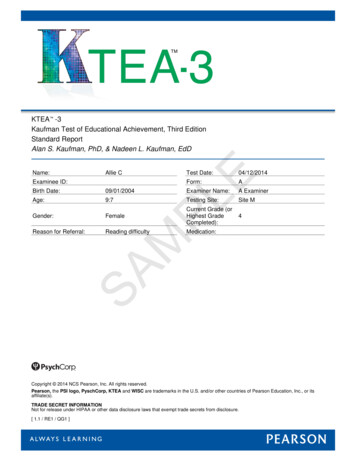
Transcription
The Raw Foods BibleThe Science Behind Living FoodsGourmet Live Food RecipesAcid and Alkaline BalancingRecommendations for Vibrant HealthRegulate Your Body Temperature With Food!Cutting Edge Information EnclosedFrom Ancient Societies to Modern Science!Craig B. Sommers, ND, CNNaturopathic DoctorLicensed Certified Nutritionist
This book is dedicated to the evolution of Humankind.Craig Sommers“Let Food Be Thy Medicine”, Hypocrites (460-377B.C.)"Craig'sRaw Food Bible is a heart filled, consciouscontribution addressing the most important foods andphysical health providers on earth. Congratulations!"Brian Clement, Director of the Hippocrates Health InstituteEdited by Linda A. Krall, Ed. S.Artwork compiled and laid out by Walter Tworkowski.ISBN 0-9744306-9-2 19.95 USTo order email RawFoodsBible@RawFoods.ComGuru Beant Press, a division of You Can Do It ProductionsCopyright 2004 Craig Sommers. This text may be used for non-commercial use without permission.Printed on recycled paper, 30% post consumer content.This book dose not diagnose disease, nor does it offer medical advice. See yourdoctor if you are unwell. The author of this book does not recommend that anyone usediet as a form of treatment for sickness without the approval of a health professional. Itis your constitutional right to make your own decisions on the treatment of illness.II
Neither the author nor the publisher assumes responsibility for any ill effects resultingfrom the use of the information contained in this book.Table of ContentsThe Mind . 2Enzymes. 4Vitamins . 11Minerals. 16Phytonutrients. 20Protein . 21Fiber. 22Essential Fats . 25Chapter Two: Studies . 29Animal Studies . 29Reproduction . 29Human Studies . 31Digestive Leucocytosis . 32Chapter Three: Common Foods . 32Nuts . 32Sprouts. 36Grains . 36Tea . 39Sea Salt . 40Ocean Grown Food. 41Thermal Properties of Foods . 44Chapter Four: Biblical References . 46The Old Testament . 46Jesus, The Lost Teachings. 48Chapter Five: Noteworthy People . 53The Albert Schweitzer Experience . 53III
Edgar Cayce, Christian Mystic. 54Thomas Edison. 55Tony Robbins . 55Brian Clement . 56Gabriel Cousens . 56Richard Schulze . 57Robert O. Young . 58Bradford Angier . 59Chapter Six: What to Avoid . 59Toxins From Cooking . 59Frying . 61Microwave Ovens . 62Trans Fats, Hydrogenated Fats & Saturated Fats . 62Artificial Sweeteners. 64Artificial Colors, Pesticides &Waxes . 65Caffeine . 68Food Borne Illness . 69Chapter 7: Recommendations For Healthy Living . 75Acid Alkaline Balancing . 75My Typical Menu . 77Cleaning Reactions/The Healing Process . 79The Liver /Gallbladder Flush . 81Oxygen / Deep Breathing . 83Deep Relaxation . 84The Mind Body Connection . 85Weight Normalization . 86Summation . 89Recipes . 91Recommended Reading/Recipe Books . 113Websites. 115IV
V
IntroductionIn this treatise, we will explore many things including thedifferences between unprocessed, uncooked foods and those thathave been processed and/or cooked. There is an ever-increasingpopulation in the United States and abroad of people who refer tothemselves as Raw or Living Foodists. In the pages to follow, I willshare scientific documentation gathered from such sources asmedical dictionaries, books authored by physicians, researchers,mystics, the Archives of the Vatican, and even the Old Testament.I have benefited greatly from a diet based on uncooked andunprocessed (whole) foods. (Scientific research proves that nutrientsare destroyed in cooking; so are cooked foods still whole foods?)Before I started on the path to healthy living, I thought I was perfectlyhealthy except for the minor problems of dandruff, athlete‟s foot,small pimples on my upper arms, reoccurring warts on my fingersand hands, love handles, a small beer belly, pinpoint hemorrhages(small red dots) on my chest, slow moving bowels, poor memory, ashort temper, and a twenty-four hour, seven day a week stuffy nose.My doctor said that none of these problems were related to my diet.I saw the registered dietitian at the medical center and she said thesame thing as the doctor. None of these problems were related tomy diet. But when I cut out the processed foods and the animalproducts and started eating mostly raw and unprocessed foods, allthese problems vanished! My life improved in every way possible! Ina matter of five years, I went from working for others for a living andjust getting by day to day, to owning a health food store and
earning a license in nutrition. During the twoyears that I spent working in my health foodstore on Long Island, counseling walk-ins ealth.Butmanytheresponsibilities of running the business took a tollon me and left me feeling stressed. Yogahelped, but the stress would return. I sold the store and went back toschool to become a Naturopath and took a teacher training coursein Kundalini Yoga. Helping people stay healthy or teaching themhow to regain their health is my life‟s work and I enjoy it very much!The MindThere is a direct connection between diet and the mind.Professor Arnold Ehret, noted European savant, raw foodist andauthor of many books, explains it rather gracefully in his book, TheMucusless Diet Healing System(page 161).“Ifyourbloodstockisformed from eating the foods Iteachyou,yourbrain willsurprise you. Your former lifewill take on the appearanceof a dream and, for the firsttime in your existence, yourconsciousness will awaken to a real self-consciousness. Your mind,2
your thinking, your ideals, your aspirations and your philosophychanges fundamentally in such a way as to beggar description. Yoursoul will shout for joy and triumph over misery of life, leaving it allbehind you. For the first time, you will feel a vibration of vitalitythrough your body (like slight electric current) that shakes youdelightfully”.I have experienced exactly what Professor Ehret explains in thisquote and believe that most anyone can experience thistransformation as well if they follow the guidelines in this book.My friend, Robert Ross talks about what it means to be a wholebeing: “The real value of a whole, raw food diet is that it empowersmore than just our health for with a healthy body and healthymind, we not only think clearly and less reactively, but with greaterawareness, understanding, sensitivity and compassion. A healthy,whole being takes full responsibility naturally, doesn‟t fall into fearand anger with a knee jerk response to adversity and hascompassion for his enemies as well as his friends.We have thatwhole being in us just waiting to come out and all we have to do isstop repressing it with toxic lifestyle and diet choices. Whole rawfoods help us get in touch with our natural power. Whole beings arenaturally powerful. The toxins in cooked and processed foodshowever, block your natural power. Many of these toxins actuallyhave a sedative-like effect on the brain.”3
Chapter One: The NutrientsEnzymesDr. Edward Howell has been involved with and studied otherresearchers‟ enzyme research for many years, finally authoring acutting edge book called Enzyme Nutrition. In this book (pages 33 &34) he states: "Life could not exist withoutenzymes. Enzymes convert the food weeat into chemical structures that can passthrough the cell membranes of the cell'slining the digestive tract and into theblood stream. Food must be digested sothat it can ultimately pass through cellmembranes.Enzymesalsoaidinconverting the prepared food into newmuscle, flesh, bone, nerves, and glands.Working with the liver they help store excess food for future energyand building needs. They also assist the kidneys, lungs, liver, skin andcolon in their important eliminative tasks. Perhaps it would be easierto write about what enzymes don't do, for they are involved inalmost every aspect of life"."There are three classes of enzymes: metabolic enzymes, whichrun our bodies, digestive enzymes, which digest our food, and foodenzymes from raw foods, which start food digestion.” "Wheningested, the enzymes in raw food, or supplementary enzymes, result4
in a significant degree of digestion, lowering the drain on theorganism's own enzyme potential" (page 3)."Any kind of heat treatment of food in the kitchen destroysenzymes. Slow or fast baking, slow and fast broiling, steaming andfrying all destroy 100 percent of enzymes in food. Vigorous boilingtakes place at 212 F. Frying is done at much higher temperatures,and in addition to destroying enzymes it also damages protein orforms new chemical compounds with unknown and possiblypathogenic possibilities, imposing still more burden upon themetabolic enzymes" (page 72)."All uncooked foods contain an abundance of food enzymeswhich correspond to the nutritional highlights of food. For example,dairy foods, oils, seeds and nuts, which are relatively high in fatcontent, also contain relatively higher concentrations of the enzymelipase which aids in the digestion of their fats. Carbohydrates, suchas grains, contain a higher concentration of amylase (digestscarbohydrates) and lesser amounts of lipase (digests fats) andprotease" (digests protein)(page 35).The banana is an excellent example of how a food is capableof digesting its own ingredients. "The banana has about 20 percentstarch when green. The enzyme amylase changes the banana into20 percent sugar when the fruit is kept warm for a few days andbecomes speckled. About one-quarter of this sugar is dextrose(glucose), needing no further digestion. The amylase in bananasworks on banana starch, but not readily on other starches, such aspotato starch. The ripe banana contains high-class raw calories that5
have not earned the evil reputation of cooked calories. Ripebananas will not make you fat" (pages calDictionary defines an enzyme as "An organic catalyst produced byliving cells but capable of acting independently. Enzymes arecomplex proteins that are capable of inducing chemical changes inother substances without being changed themselves. Enzymes arespecific in their action. They will act only upon a certain substance ora group of closely related chemical substances and no other. Eachenzyme has an optimum temperature at which it acts with greatestefficiency, and is influenced by the reaction of the medium in whichit acts, there being an optimum degree of acidity or alkalinity.Enzyme activity can be retarded or inhibited by low temperatures,high temperatures, and the presence of salts of heavy metals,dehydration, and ultraviolet radiation. Several hundred enzymeshave been identified but as many as a thousand are thought to bepresent in mammals.”Professor Artturi Virtunen, Helsinki biochemist and Nobel Prizewinner, showed that enzymes are released in the mouth from rawvegetables when they are chewed: they come into contact with thefood and start the act of digestion. And these food enzymes are notdenatured by stomach acid, as some researchers have suggested,but remain active throughout the digestive tract. (Optimum NutritionBible, page 91).So what's the big deal about getting these digestive enzymesfrom the diet as opposed to using the body's organs to supply thedigestive enzymes? According to the research done by Dr. Howell,6
enzyme expert, each individual has what he calls an "enzymepotential or enzyme bank account" and when it runs out, the being'slife ends. How does one's enzyme bank account get depleted?According to Dr. Howell, "heavy withdrawals, and skimpy deposits.""Enzyme Nutrition points out that each one of us is given alimitedsupplyofbodilyenzyme energy at birth. Thissupply, like the energy supplyin your new battery, has to lasta lifetime. The faster you useup your enzyme supply, theshorter your life. A great dealofourenzymewastedenergyishaphazardlythroughout life. The habit ofcooking our food and eating itprocessed with chemicals; andthe use of alcohol, drugs, and junk food all draw out tremendousquantities of enzymes from our limited supply. Frequent colds andfevers and exposure to extremes of temperature also deplete thesupply. A body in such a weakened, enzyme-deficient state is degenerative problems. A lifetime of such abuse ends in the tragedyof death at middle age" (Enzyme Nutrition, Introduction pages ix andx)."The length of life is inversely proportional to the rate ofexhaustion of the enzyme potential of an organism. The increased7
use of food enzymes promotes a decreased rate of exhaustion ofthe enzyme potential." (Dr. Edward Howell, The Enzyme NutritionAxiom). One of the keys to a healthy, long life is to consume dietaryenzymes so that the body conserves the metabolic enzymes anduses them for other functions."The remarkable thing about the eventual bankruptcy of theenzyme account is that it can proceed quite painlessly, withoutimmediate symptoms. The only warning may be a belatedmalfunction or breakdowns in some organ far removed from thedigestive tract. But the diagnostician unaware of the importance ofenzyme nutrition would have difficulty in connecting such a referredprocess to the true, underlying cause. This is how an assortment ofhuman ailments may get started" (page 73).Enzymes can also disarm free radicals. "Apples, mangos andgrapes contain enzymes called peroxidase and catulase which helpdisarm free radicals" (Optimum Nutrition Bible, pages 91-92). Somemushrooms, sweet corn and raw honey also contain these enzymesalong with amylase. However, when these foods are cooked, thebeneficial enzymes are destroyed.There are some foods that contain enzyme inhibitors.Forexample, lentils, beans and chickpeas contain trypsin-inhibitors thatprevent protein from being completely digested. However, this antienzyme factor is destroyed either by sprouting or cooking them. Thesame is true for grains rich in phytates that can bind beneficialminerals. If these enzyme blockers are not inactivated, they cancause an enzyme drain on the body and cause intestinal gas. Nutswith brown skins such as almonds contain enzyme inhibitors. Soaking8
the nuts deactivates these inhibiters (This is covered in detail in thechapter on nuts).“Previously, food was considered to have no effects except forthe production of heat and energy from fats and carbohydratesand the repair of tissue by proteins. Now it is known that food canchange organs and tissues, including glands, for better or worse. Thefact that food can change the size and weight of these importantglands (pituitary, testicle, ovaries, pancreas, adrenal, thyroid) hasbeen demonstrated over and over again by careful experimentsduring past years. Professor Jackson and co-workers at the Universityof Minnesota fed white rats a diet containing 80 percent sugar(enzyme free) and reported marked differences in the size andweight of all principal organs and glands" (Enzyme Nutrition page104)."Heat-treated, enzyme-free, refined items of food caused themost drastic deviations in pituitary gland size and appearance.When animals were fed diets greatly restricted in enzymes, thedamage in the pituitary was identical or similar to that found inhuman beings subsisting on conventional food with greatly loweredfood enzyme intake" (page 106). The Taber’s Cyclopedic MedicalDictionary, edition 17, (page 1516) says the following about thefunction of the pituitary gland. “The pituitary is an endocrine glandsecreting a number of hormones that regulate many bodilyprocesses, including growth, reproduction, and various metabolicactivities. It is often referred to as the master gland of the body ” Ithas been proven that a predominantly cooked food diet can makeone‟s “master gland” that regulates so many bodily functions, shrink!9
Do you think that this could be a contributing factor in the cause ofthe diseases of modern society? I do.Dr. Howell explains how a predominately cooked food dietcauses an enlargement of the pancreas. "The pancreas must sendmessages to all parts of the body looking for enzymes it canreprocess into digestive enzymes. It may even invade the warehouseof the precursors. In a pinch it will beg, borrow or steal them. When itfinds them it has work to do. Changing metabolic enzymes intodigestive enzymes means extra work for the pancreas. It must getbigger, just as muscle grows from more exercise." "Either way, yourbrain, heart, arteries, all organs and tissues suffer from an enzymelabor shortage" (Enzyme Nutrition, page 81.)Dr. Howell has assessed more than fifty reports submitted in thescientific periodical literature on nutrition and brain weight over anumber of years. He found that animals fed a diet, "armed to the hiltwith various vitamins and minerals, " but completely free of foodenzymes had consistently lower brain weights than animals fed adiet consisting of a mixture of cooked and uncooked foods (page76).I very rarely indulge in cooked foods, but if I do, I consume adietary supplement of plant-based enzymes in veggie capsules.These pills help me digest the enzyme free food so that my bodydoes not have to generate as many digestive enzymes, thereforekeeping my system from this burden. If you decide to go this route,beware of animal based enzymes. They may come from thepancreas of a pig or other animal. One popular product is Ox bile(from the stomach of an Ox). These enzymes work only in a particular10
pH, unlike plant enzymes, which work under a broad range of acidityor alkalinity. Since they come from an animal and cannot be heatedto sterilize (or they would kill the enzymes and not work), commonsense tells me to beware.VitaminsThe word, “vitamin” appeared in the English dictionary in 1934.It is described as an organic substance which the body requires invery small amounts to carry out thousands of building-up andbreaking-down functions.The vitamins in our foods are sometimes rendered inactivebefore we get a chance to consume them. The Taber’s CyclopediaMedical Dictionary, Edition 17, has this to say about vitamin loss(page 1562): “Loss of vitamin content in food products because ofvitamin instability, especially in oxidation and during heating.Methods of preserving foods add to the loss of vitamins. Pickling,salting, curing or fermenting processes usually cause complete lossof Vitamin C. Commercial canning destroys from fifty to eighty-fivepercent of Vitamin C contained in peas, lima beans, spinach andasparagus. Pasteurization, unless special precautions are observed,causes a loss of from thirty to sixty percent of Vitamin C. Freshlyprepared applesauce retains only from twenty to thirty percent ofthe Vitamin C value of the apple. Vitamin B1 is lost through millingbecause the wheat embryo, rich in Vitamin B1, is removed fromwheat flour in milling. Some vitamins are unstable, being readily11
destroyed by oxidation, heat, especially in an alkaline medium ofstrong acids, light and aging.”The Vitamin Chart in this prestigious medical dictionary statesthe following (edition 14, page 1725): Vitamin A, “destroyed by high temperatures when oxygen ispresent.” Vitamin B1, “destroyed by exposure to heat, alkali orsulphites.” Vitamin B2, “unstable in light, especially in the presence ofalkali.” Vitamin B6, “rapidly inactivated in the presence of heat,sunlight, or air.” Folic Acid, “destroyed by heat at low pH, loss in food storedat room temperature” (edition 19 page 2399). Vitamin C, “easily destroyed by oxidation; heat hastens theprocess. Lost in cooking, particularly if water in which food iscooked is discarded. Also loss is greater if cooked in iron orcopper utensils.” Vitamin B Complex, stability, “long continued cooking orhigh temperature cooking destroys Vitamin B.” Vitamin B12, “unstable in hot alkaline or acid solutions”(edition 19 page 2399). Vitamin E, “destroyed by heat” (edition 19, page 2399).Vitamin B12 is heat sensitive but not entirely destroyed bycooking. Research has shown that between 23.7% and 96.4% of B12is destroyed by boiling or baking, depeding on the type of food andlength of time cooking. (Conscious Eating by Gabriel Cousens, MD)12
The Vitamin E Fact Book by the Vitamin E Research andInformation Service (1989) states that almonds are a rich source ofVitamin E in their raw state but they lose eighty percent of thevitamin in roasting.Vitamin C is a very interesting vitamin. Practically all animalsmake it in their bodies so they don‟t have to eat it. The exceptionsare fruit-eating bats, guinea pigs, the red-vented bulbous bird andprimates including man. Linus Pauling, a famous Vitamin Cresearcher, postulated that humans used to make it. However,from eating a fruit rich diet, we lost the ability to produce it. It iswidely known that if we don‟t get Vitamin C through our diets, wedevelop scurvy.Vitamin D is known as the “sunshine vitamin.” In other words,when our bodies are exposed to sunlight, (usually twenty minutes issufficient) we are supplied with our daily need for vitamin D. Ababy can get all the vitamin D it needs with only its cheeksexposed to the sun for about twenty minutes.There are large numbers of illnesses that can be caused byvitamin deficiencies. Volumes can be written on this topic alone(excluding all other nutrients). Just to name a few, lack of vitaminA can cause the eyes to weaken. Lack of vitamin B can causeberiberi. Lack of vitamin C can cause scurvy and lack of vitamin ndations for these vitamins to prevent serecommendations are less than optimum. Every individual has adifferent need for vitamins that changes constantly according to13
lifestyle factors. In the case of water-soluble vitamins, if overingested, they will usually leave the body through the urine andnot cause any problems. Fat soluble vitamins such as A, D, E and K,are stored in the liver and fatty tissues until the body needs them.The body can survive weeks of consuming foods that lack themwithout any deficiency signs for this reason. However, there is amajor drawback to this. The capacity for storage sets the stage fortoxic buildup should an excess be ingested. Excess of vitamins A, Dand K can easily reach toxic levels if over consumed. For example,a man diving an Alaskan dog sled got lost, and in an attempt tosave himself from death, the stranded man ate the liver of one ofthe dogs and then died of Vitamin A toxicity. If however a humanate an excess of plant foods, toxic levels of vitamin A would neverbe reached because plants contain carotinoids that are changedinto vitamin A only as the body needs them.Synergistic and opposing relationships exist between somevitamins. For example, Vitamins A, D and E are mutuallyantagonistic to each other and it is well known that hypervitaminosis A can be treated by vitamin D supplementation. Inaddition, an excess of vitamin D in the body can be successfullytreated with vitamin A supplementation. An excess of the mineralcalcium in the body can cause a vitamin A deficiency and adeficiency of the mineral zinc can prevent the body fromaccessing Vitamin A that is stored in the liver. Vitamin D canbecome deficient if excess magnesium is present. You can seehow indiscriminate supplementation or eating an excess of fortifiedfoods can cause imbalance. Foods in their natural state as the14
d/hybridized foods have the vitamins and minerals in highlyuseable ratios. With normal consumption of a good variety, theywill not cause imbalance. However, if we eat refined andprocessed foods that have been enriched with synthetic vitaminsand laboratory manipulated minerals and then consume syntheticsupplemental vitamins in high doses, there is a possibility ofthrowing body chemistry out of balance. If you use supplementalvitamins, be sure to use quality products from a health food storeand never from discount stores, pharmacies or supermarkets.Sometimes these supplements contain artificial chemicals that cancause ill health.According to research done by Dr. David L. Watts, somevitamins have been classified as having either a stimulating orsedating effect at the cellular level. For most people, the vitaminsA, C, E, B1, B3, B6 and B10 are stimulators while vitamins D, B2 andB12 are sedatives.I have often wondered if the high dose of vitamin D absorbedfrom the sun is the reason why most people feel so sedated after aday at the beach.15
MineralsMineral deficiencies can cause disease in humans. Forexample, goiter is an enlargement of the thyroid gland (in thethroat) can be caused by a deficiency of the mineral iodine.When Iodine is added to the diet, the goiter goes away.Mineral toxicity is widely recognized. The problems in childrenwho have eaten lead based paints that were peeling off the wallsand then suffered lead toxicity is an example. Many historiansbelieve that the fall of the Roman Empire was caused by leadpoisoning.When occurring in food, fluorine is completely different fromsodium fluoride that is chemically produced. Naturally occurringfluorine when consumed in plant matter benefits teeth and bonesand can even help to protect us from germs but fluorineevaporates from food with cooking. Sodium fluoride (known alsoas fluoride or sodium monofluorophosphate), unfortunately, doesnot evaporate from the boiling of treated water and can causemany health problems in the human body. According to PaulPitchford (and other researchers) in “Healing With Whole Foods”,sodium fluoride inhibits proper functioning of the thyroid gland andall enzyme systems and damages the immune system. He also liststhe following disorders that may result from ingesting this toxin:arthritis (various forms of), lupus, and sclera derma. ndotherdegenerative conditions. Have you ever read the warning label ontoothpaste with added fluoride? It is very scary. It reads, “If you16
fessional assistance or contact a poison control centerimmediately”. I recommend fluoride free toothpaste.Many minerals are lost in cooking. Eleonore Blaurock Busch,PhD. states in her book, Mineral And Trace Element Analysis,“Selenium compounds are unstable and loss of the mineral occursduring cooking.” Selenium is a very important mineral. One of themany ways that our bodies use it is as an antioxidant inconjunction with vitamin E.There are als
There is a direct connection between diet and the mind. Professor Arnold Ehret, noted European savant, raw foodist and author of many books, explains it rather gracefully in his book, The Mucusless Diet Healing System (page 161). “If your bloodstock is formed from ea


